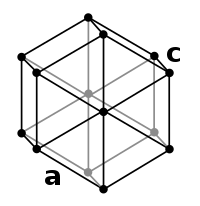
Photo from wikipedia
Abstract We conducted a techno-economic and thermodynamic analysis of precooling units (PCUs) at hydrogen refueling stations and developed a cost-minimizing design algorithm for the PCU observing the SAE J2601 refueling… Click to show full abstract
Abstract We conducted a techno-economic and thermodynamic analysis of precooling units (PCUs) at hydrogen refueling stations and developed a cost-minimizing design algorithm for the PCU observing the SAE J2601 refueling protocol for T40 stations (requiring −40 ° C precooling temperature). In so doing, we identified major factors that affect PCU cost and energy use. The hydrogen precooling energy intensity depends strongly on the station utilization rate, but approaches 0.3 kWh e /kg-H 2 at full utilization. In early fuel cell electric vehicle markets where utilization of the refueling capacity is low, the overhead cooling load (to keep the heat exchanger cold at −40 °C) results in significantly high PCU energy intensity because only a small amount of hydrogen is being dispensed. We developed a parameterized precooling energy intensity prediction formula as a function of the ambient temperature and station utilization rate. We also found that the Joule-Thomson effect of the flow control device introduces a significant increase in temperature upstream of the PCU's heat exchanger (HX), which impacts the PCU design capacity. An optimal PCU (per dispenser, at 35 °C HX inlet temperature) consists of a 13-kW refrigerator and a HX with 1400 kg of thermal mass (aluminum), which currently costs $70,000 (uninstalled). The total (installed) capital and operation cost of PCU at a fully utilized hydrogen refueling station adds $0.50/kg-H 2 .
Journal Title: International Journal of Hydrogen Energy
Year Published: 2017
Link to full text (if available)
Share on Social Media: Sign Up to like & get
recommendations!